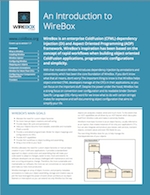Overview
What is dependency injection?
Dependency injection is the art of making work come home to you. Dhanji R. Prasanna
WireBox alleviates the need for custom object factories or manual object creation in your ColdFusion (CFML) applications. It provides a standardized approach to object construction and assembling that will make your code easier to adapt to changes, easier to test, mock and extend.
As software developers we are always challenged with maintenance and one ever occurring annoyance, change. Therefore, the more sustainable and maintainable our software, the more we can concentrate on real problems and make our lives more productive. WireBox leverages an array of metadata annotations to make your object assembling, storage and creation easy as pie! We have leveraged the power of event driven architecture via object listeners or interceptors so you can extend not only WireBox but the way objects are analyzed, created, wired and much more. To the extent that our AOP capabilities are all driven by our AOP listener which decouples itself from WireBox code and makes it extremely flexible.
We have also seen the value of a central location for object configuration and behavior so we created our very own WireBox Programmatic Mapping DSL (Domain Specific Language) that you can use to define object construction, relationships, AOP, etc in pure ColdFusion (No XML!). We welcome you to stick around and read our documentation so you can see the true value of WireBox in your web applications.
Dependency Injection Explained
We have released one of our chapters from our CBOX202: Dependency Injection course that deals with getting started with Dependency Injection, the problem, the benefits and the solutions. We encourage you to download it, print it, share it, digest it and learn it: http://ortus-public.s3.amazonaws.com/cbox202-unit1-3.pdf
If you require any training please contact us.
Advantages of a DI Framework
Compared to manual Dependency Injection (DI), using WireBox can lead to the following advantages:
You will write less boilerplate code.
By giving WireBox DI responsibilities, you will stop creating objects manually or using custom object factories.
You can leverage object persistence scopes for performance and scalability. Even create time persisted objects.
You will not have any object creation or wiring code in your application, but have it abstracted via WireBox. Which will lead to more cohesive code that is not plagued with boilerplate code or factory code.
Objects will become more testable and easier to mock, which in turn can accelerate your development by using a TDD (Test Driven Development), BDD (Behavior Driven Development) approach.
Once WireBox leverages your objects you can take advantage of AOP or other event life cycle processes to really get funky with OO.
Features at a Glance
Here are a simple listing of features WireBox brings to the table:
Annotation driven dependency injection
0 configuration mode or a programmatic binder configuration approach via ColdFusion (No XML!)
Creation and Wiring of or by:
ColdFusion Components
Java Classes
RSS Feeds
WebService objects
Constant values
DSL string building
Factory Methods
Providers
Multiple Injection Styles: Property, Setter, Method, Constructor
Automatic Package/Directory object scanning and registration
Multiple object life cycle persistence scopes:
No Scope (Transients)
Singletons
Request Scoped
Session Scoped
Application Scoped
Server Scoped
CacheBox Scoped
Integrated caching via CacheBox, scale your objects and metadata
Integrated logging via LogBox, never try to figure out what in the world the DI engine is doing
Parent Factories
Factory Method Object Creations
Object life cycle events via WireBox Listeners/Interceptors
Customizable injection DSL
WireBox object providers to avoid scope-widening issues on time/volatile persisted objects
WireBox RefCard
Our Wirebox RefCard will get you up and running in no time 
Useful Resources
Was this helpful?